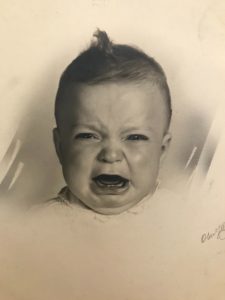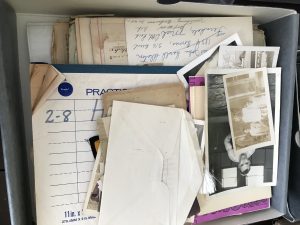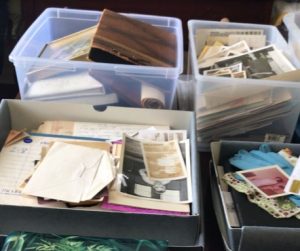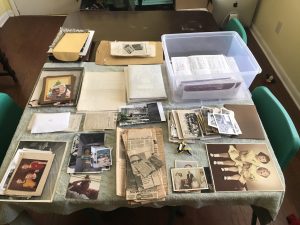calsfoundation@cals.org
It’s a marathon, not a sprint: Personal Archiving

Personal archiving can be scary and overwhelming. You probably have boxes and boxes of photos and papers and letters in attics, basements, and garages. Family papers can be spread over the households of several family members in multiple locations. And it can be an intimidating process because you want to make sure you do it right the first time.
And I’ll let you in on a little secret. Personal archiving scares me, too! And I have the training and professional experience to know what I’m doing. For instance, I know not to write on the backs of photographs and not to use tape and to store all materials in a cool, dry place. But the process of getting all those boxes out and organizing everything then digitizing everything is just overwhelming! So it’s a little like the cobbler’s child not having shoes… My personal family papers and photographs are a mess.
The Butler Center for Arkansas Studies had been planning a series of in-person personal archiving classes for May, but then COVID-19 hit and instead of putting them off indefinitely, we decided to have the program virtually. And that meant that I needed to put my personal archiving project on fast forward so I could show people how to tackle it all—and how it can realistically work for non-archivists.

Many history nerds like me have been archiving all our lives, saving things here and there over the years to document our existence on the planet. Because of my chosen profession—public history—I became the de facto family historian for both sides of my family. As family members aged or died, I was given boxes, bags, and trunks of family photos, documents, and keepsakes to protect, preserve, and house for eternity. Or at least my lifetime!
We can learn so much from the past, and the past informs so much of who we are and why we do the things we do as a culture and a community today. There are so many connections between our reality today (outside of the COVID-19 pandemic) and the past. For historians, the personal papers of everyday people are the great discoveries and treasures of the work we do. I would argue that personal archives—personal papers of everyday people—are more important and more significant to the study of human history than the papers of the famous or the infamous. Honestly, I’ll take a stack of letters by somebody who hasn’t done anything over someone who was elected to public office or did something to change the world. Plus there are more of us—everyday people—than there are of them, and the details of our lives are going to tell a more accurate story of how we lived. The papers, photographs, and letters you’ve got stored in your basement, attic, and closets can show us how things used to be done and how things in our world have changed.

The first step in personal archiving is getting all the stuff out of all the hiding places and assessing what you have. And as with many first steps, this one can be a tough one. And give yourself more than a few hours. You need at least a weekend. Find a large flat surface. I used my dining table because no one is coming over to dine right now anyway. Also, consider any pets or small children that might be curious about what you are doing and become overly involved. A guest room with a door that can be closed might be a better choice. This is a marathon, not a sprint, and you will need to be able to walk away from the project and come back to it. I wouldn’t want to have to pack it all up every time I take a break from it.
And after you get it all out in the open, you will start the clumping process.
Clumping is just that—clumping similar things together. You want to work with one box or container at a time. Clump photographs together. Clump letters together. Clump papers together. Clump newspaper clippings together. All the loose things in those boxes get clumped with other like things. (Don’t worry about photo albums and scrapbooks right now. That’s a different blog post.) For more specifics on clumping, check out session 1 of our Personal Archiving program on YouTube.

Once you have gone through all the boxes and all the containers and clumped together the like things, it’s time to start looking at what you have and how you will further organize your collection. I like to organize by individual people.
So I have a collection of items related to
- my paternal grandmother
- my paternal great-aunt (paternal grandmother’s sister)
- my maternal grandparents
- my maternal great-aunt (maternal grandmother’s sister)
- my parents
- me
So that is six separate but related collections. Each collection will have a series for photographs, a series for letters, a series for papers, and a series for miscellany. Some collections will be mostly photographs. Others will be business papers, letters, and other documents. What is in a collection can tell you a lot about what was important to that person!
That is why I tackle one box at a time: in most cases, my boxes are specific to specific people. (Note: I did have one box that was a bunch of stuff from both sides of the family, and I took the time to divide those items into their rightful places.)
As historians and archivists, we have standards and practices that we use when working with archival collections. We use special boxes and containers. Things like acid-free, buffered, unbuffered, PAT, and polypropylene matter to us. We worry about relative humidity. But many of the supplies we use in an archive or museum are too expensive or difficult to get for someone wanting to organize and digitize their personal papers for themselves. However, writing on photographs, using tape, and storing on CD-ROMs are still big no-nos even for the layperson. But there are some great cost-effective solutions for people to get started archiving their personal photos and papers. Learn all about the evils of tape in session 2 of the Personal Archiving program.
I was very fortunate. Three of my four grandparents lived well into my adult years. I asked them lots of questions about their lives and spent time poring over photographs, photo albums, and scrapbooks. Those visual reminders helped jog their memories. They didn’t always want to talk to me about the past and I heard more than once, “Why are you interested in those old stories?” but I’m so glad I was persistent. As I clump, sort, and organize the boxes, tubs, and albums, I have those stories to help me connect the dots and figure out who is who. Genealogy is going to be an important part of your personal archiving. Learn about doing genealogy as part of your personal archiving journey in session 3.
After you have clumped, organized, preserved, and researched, you are FINALLY ready to digitize your stuff.
In 2019, the Central Arkansas Library System received a grant from the Memory Lab Network. Created by the DC Public Library and funded by the Institute for Museum and Library Services, the grant provides training and funding for us to create our own DIY Memory Lab at the CALS Roberts Library. The Memory Lab will be available for patrons to scan their old photographs and digitize their VHS tapes and audio cassettes that contain personal home videos or audio recordings. We’ve had to delay those plans because of the COVID-19 pandemic, but we have created a final session that covers some digitizing you can do until then.
Remember: this is a marathon, not a sprint. You will not get it all done this weekend or next week. Take your time and enjoy the process. Start a family group on Facebook or make a family group text to share with other members of your family. You might need to ask questions about the bald man in all the photos! Use technology—just as we’ve learned to do to remain connected during social distancing with school and work—to communicate with your aunts, uncles, and cousins. Then, share with us your discoveries (here in the comments or on social media). And good luck!
By Heather Zbinden, CALS Roberts Library outreach coordinator




